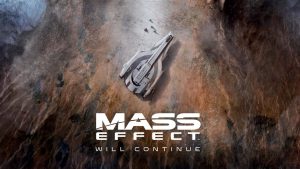
It has been a long wait for Starfield, and countless fans have been waiting with bated breath for this highly anticipated space epic. And we’re happy to report that the game is everything that fans expected, and Starfield impresses from its grand sense of scale to improved combat designs and much more. It’s definitely the exclusive that Microsoft desperately needed after all this time, and it makes good use of the current-gen platforms to spin a complex web of mechanics and systems that beautifully weave into one another to create an unforgettable experience.
So, how does the game perform on a technical level? How has the Creation engine evolved from its past renditions? And what are the differences between the PC version and the Xbox Series X? These are the questions that we aim to answer with this comprehensive technical analysis of Starfield.
Game Engine And Overview

Starfield is Bethesda’s first game to be developed using Creation Engine 2, which is an updated version of the Creation Engine that we saw in games like Fallout 76. The rendering pipeline has seen massive improvements in key areas like environmental rendering and physically based materials, but it’s more of an evolution than a complete redoing of what came before.
This means that we don’t get to see cutting-edge rendering techniques like ray tracing being utilized in this project, which is a shame because the game could have benefitted a lot with such an implementation. But there’s a lot to like here as well, and we will be discussing those features in detail in further sections.
System Requirements And PC Parameters
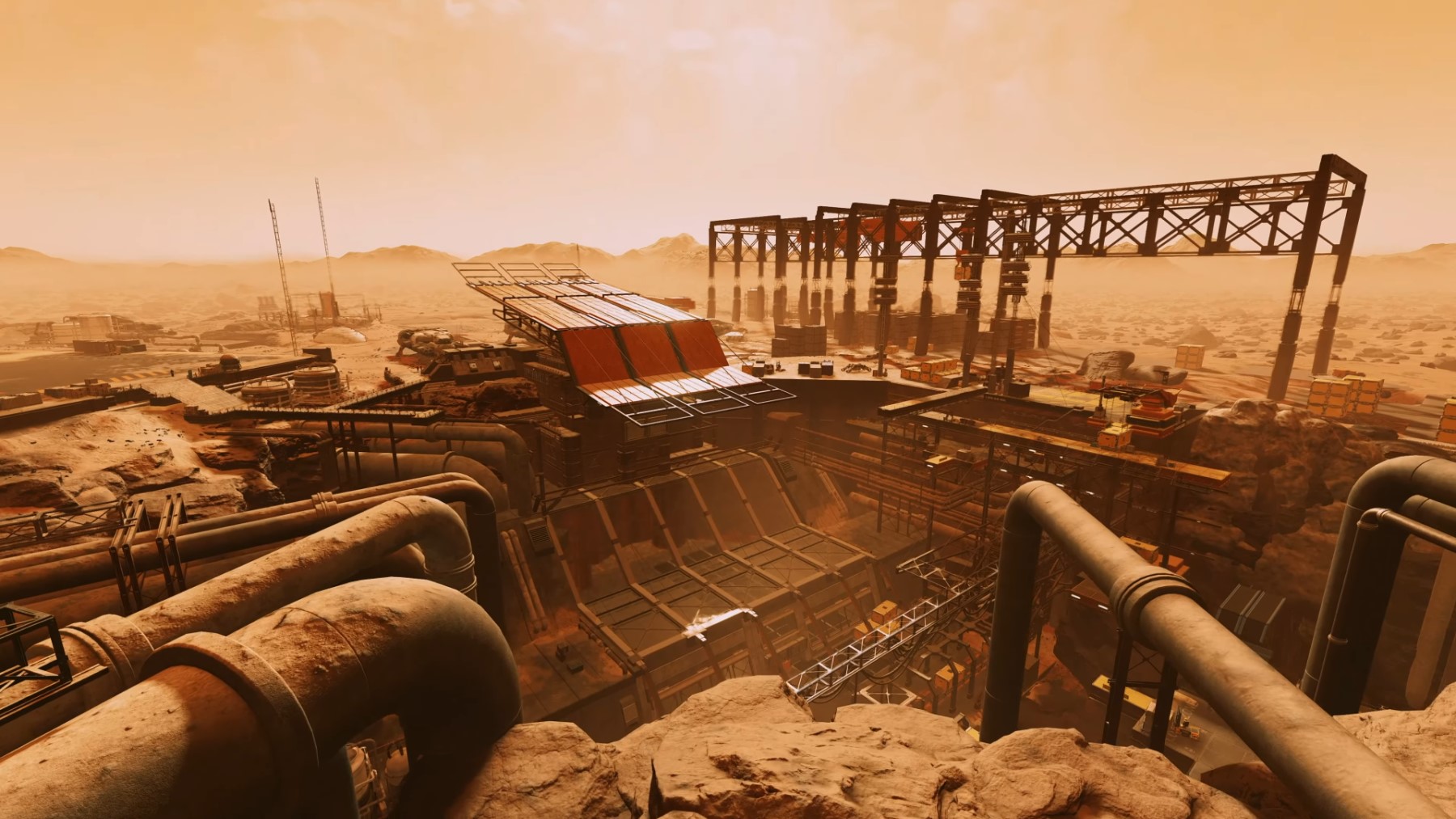
In addition to the Xbox Series X version, we also tested the game on a high-end PC to get a taste of how it looks and performs in comparison to the console version. According to the official website, Starfield requires that players have a Ryzen 5 3600X, RTX 2080, and 16 GB of RAM to be able to run the game at comfortable framerates on a high resolution. Our test rig consists of Ryzen 9 5950X, Nvidia RTX 3080Ti, and 32 GB of RAM which is well over what the game recommends for itself. We also installed the game on a PCI e 4.0 SSD so that load times are snappy.
Opening the graphics settings menu, we get a slew of sliders ranging from volumetric lighting to contact shadows and crowd density to help you achieve the desired balance between fidelity and performance. The settings menu definitely leaves something to be desired as you don’t get comparison images or explanations as to what each of the settings does and how it impacts performance.
As for our test settings, we went with a mix of high and ultra settings and turned FSR 2.0 to help with upscaling a lower-resolution internal image to our target resolution of 4K. It’s a shame that Starfield doesn’t support DLSS upscaling on PC, but FSR does a good job of upscaling the image without any visible signs of artifacts.
Character Models
Let’s start off by looking at Starfield’s character models. Bethesda’s RPGs have never really featured character models that could be considered impressive, and that sentiment unfortunately extends over to Starfield as well. Not to say there aren’t any improvements either, but the end result isn’t anything that screams next-gen.
The skin meshes definitely have a lot more detail than something like Fallout 76, and the physically based materials used in the clothes also look a lot better than prior renditions of the Creation Engine. Fidelity levels also vary from model to model, and characters that are crucial to the story obviously look better than random NPCs that you would find during your travels.
Facial animations are still powered by automation, which means that facial expressions can vary wildly from somewhat believable to downright hilarious at times. While one would say that’s a natural compromise for a game of this scale, Starfield’s primitive approach to facial animation leaves a lot to be desired despite it being markedly improved from what came before.
Lighting, Reflections, And Shadows

As for the lighting, Starfield uses a unique real-time global illumination solution to light up the many environments that come together to create this gargantuan open world. The game doesn’t feature any form of ray tracing, so the global illumination is most likely a probe-based solution. The end result isn’t the most accurate, but it works well for the most part and the GI solution performs decently across a wide range of scenarios for both direct and indirect light sources.
The same story of using last-gen techniques continues over to the reflections as well, which look to be of the screen space kind. Reflections seem to be running at a fraction of the screen resolution and update with each frame to align with the player’s perspective. Reflections on surfaces like tables and windows don’t reflect the NPCs in the environment, which can look pretty weird when you zoom in to see the details.
As for the shadows, we get to see some really crisp shadows on not only the PC version but also the console counterparts. There are some artifacts present around shadow maps cast from fine objects like grass, but on the whole – it looks really good. In addition to this, Starfield casts shadow maps for distant objects as well which helps in giving the open-world a consistent look and feel.
Environments
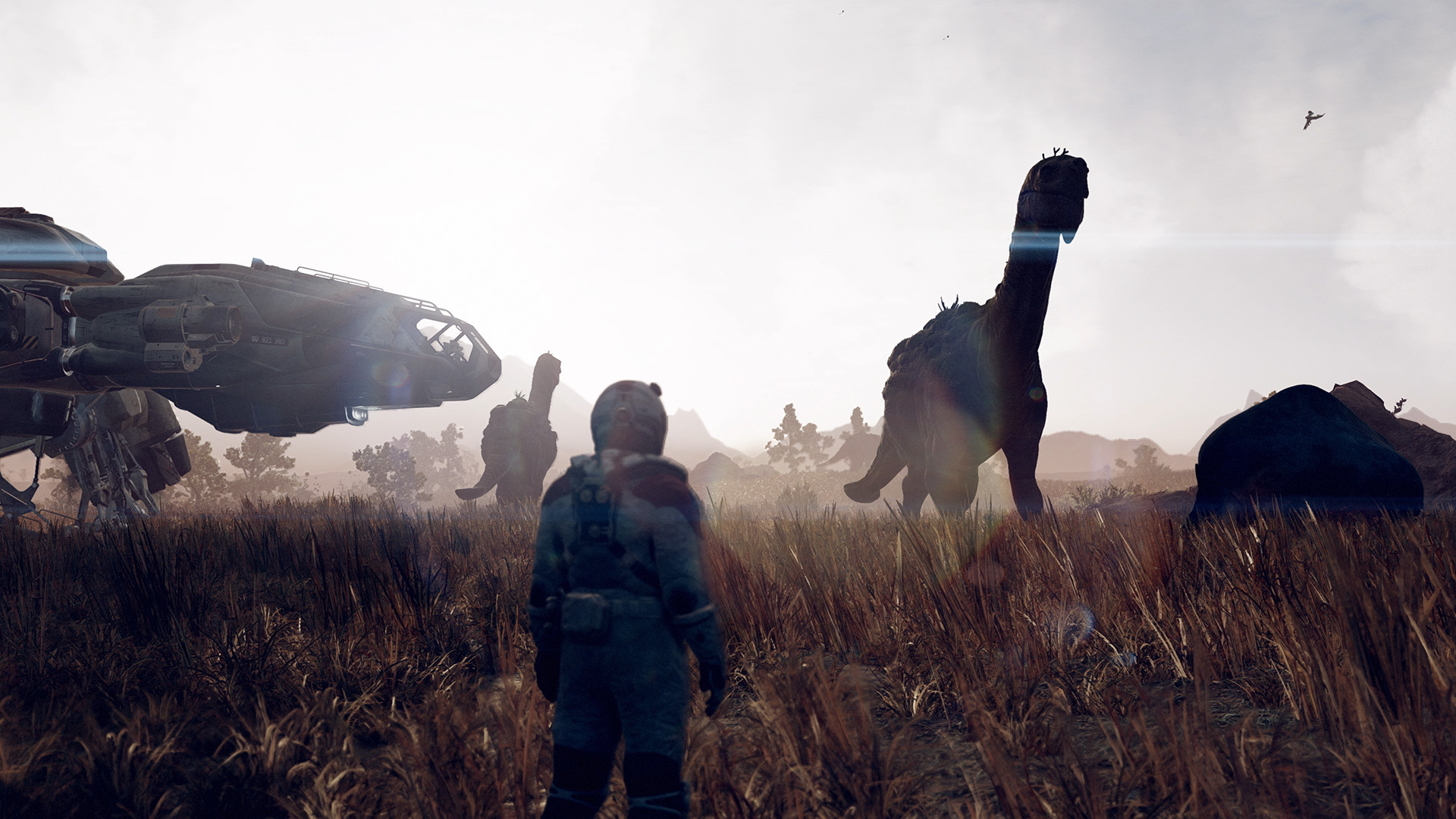
Switching gears over to the environment, Starfield presents a vast number of locales that each look differently from one another. The asset quality has seen a lot of improvements, and the terrain texture generally looks really good. Whether you’re skirting along giant rocks in outer space or exploring a distant planet, the terrain features some impressive geometric complexity that comes together to create a visually pleasing image of outdoor environments.
Of course, it also helps that this space is filled with all sorts of interesting structures and trees which makes for a living and breathing world. Starfield also makes great use of dense height fog to accentuate a sense of scale within the planet, and you will notice thick volumetric fog in the distance which also helps to hide the low level of detail in faraway areas. The level of detail swapping is also pretty smooth for the most part, though you might notice some pop-ins at times.
The world streaming also works really well, though it needs to be noted that Starfield isn’t a seamless open-world experience. Moving from indoors to outdoors and traveling between planets will trigger a loading screen that lasts anywhere from 4 to 6 seconds, and it can cause a brief slowdown as everything loads into memory.
As you move towards the settlements and indoor environments, you will get to appreciate the NASA Punk designs of Starfield. Everything from the architecture of settlements to the high-tech gadgets all around to even the clothing strikes a great balance between realism and sci-fi fantasy, and it’s all brought to life by some great use of physically based materials.
Most of the world and structures are made up of rough surfaces that reflect little light into the surroundings, which gives these environments a sort of flat look. But the gorgeous art direction and smart use of colors ensures that the flat look isn’t a boring one, instead, it results in a distinct visual tone that slowly grows on the player.
Animations
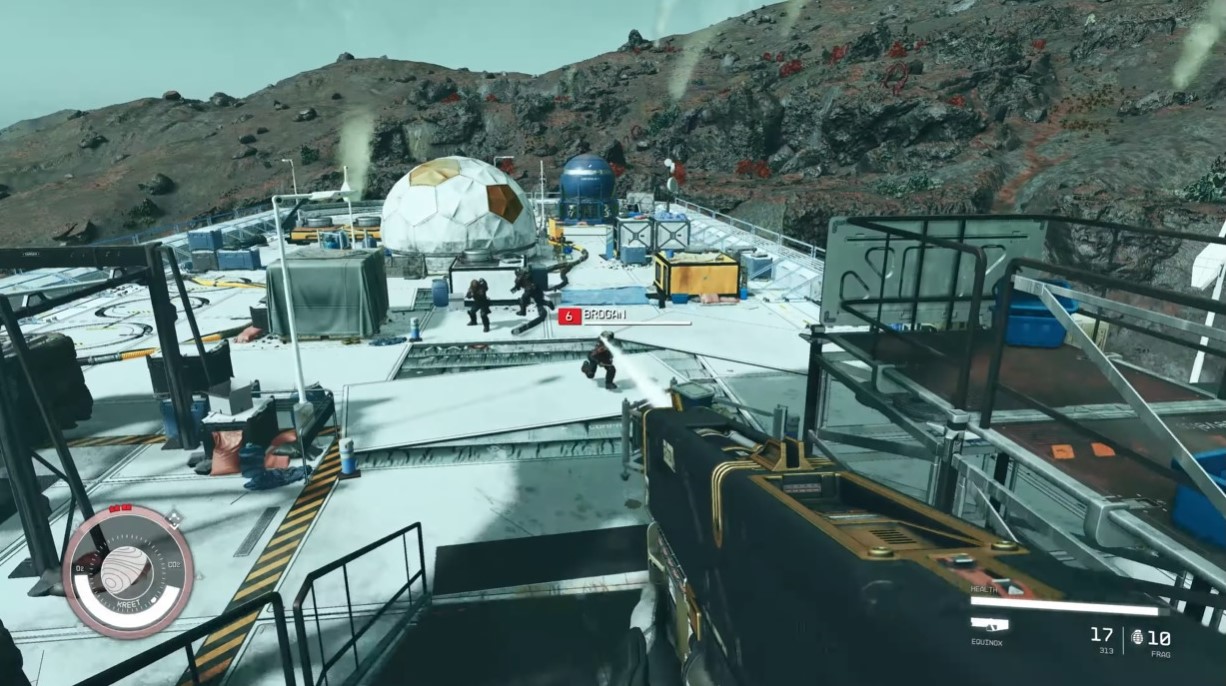
Whether you’re slashing your way through skeletons in Skyrim or fighting mutants in the post-apocalyptic world of Fallout, the animations in Bethesda’s games always tend to be stiff with heavy movements that aren’t the most responsive. Starfield takes some big strides in this department, which results in a far more enjoyable combat experience this time around.
Animations are snappy and player movements are precise and responsive, whether you play in the first-person perspective or third-person. It is a big improvement over past releases from the developer. You can also use a jetpack to leap up in the air and take out enemies from afar, and it all works really smoothly. Guns also pack the right amount of punch, and each shot from your weapon is accompanied by generous amounts of visual feedback.
Post Processing

Switching over to the post-processing side of things, Starfield uses motion blur to make its action feel more cinematic (though you can turn off this feature in the option menu). The motion blur is of the per-pixel kind, and it looks really good in action. Conversations with quest-givers also give us a good look at the depth of field implementation, which is appropriately high quality and shows little to no signs of artifacts along the edges.
Volumetric fog is also an important part of Starfield’s presentation, and as mentioned previously as well – you will get to see a generous amount of volumetric fog throughout its planets and settlements. These volumetric meshes also diffuse light out into the surroundings, and they add an element of richness to the many environments. We also get to see alpha particles used to great effect in not only explosions but also during gunfights that involve energy-beam weapons.
Xbox Series X Parameters And Comparison To PC Version

The Xbox Series X version offers no choices in terms of graphics modes. The default mode locks the frame rate to 30fps and outputs an upscaled 4K image, and there are no additional performance modes to speak of. Starfield is a vast game with plenty of moving parts that can eat up CPU resources, so it’s no surprise that consoles don’t get a 60fps option with this release. That said, Starfield could have gone for a 40fps performance mode for 120 Hz displays – but that’s sadly not the case.
As for the differences between the Xbox Series X version and our mostly maxed-out PC version, we were hard-pressed to find any noticeable changes. A ton of what makes Starfield’s look so distinct is the superb art direction, and that obviously is retained across both versions alongside the rendering techniques used to bring that vision to life.
That said, there are a few differences that eagle-eyed players might be able to make out, ranging from better distant detail to denser skin meshes on the PC version. Image quality is definitely one of the biggest differences between the two, and the PC version has a much crisper image than its console counterpart – and we suspect that it has to do with minimal anti-aliasing in the Xbox Series X version.
Performance And Stability
Performance-wise, the console version does a great job of sticking to its 30fps target. We noticed minor frame rate drops, especially while loading into a new planet – but it bounces back up once everything is loaded into memory. We did have a much better experience on PC where everything ran smoothly at 60fps, and there were very few inconsistencies to speak of.
As for the stability, there were a few minor bugs and glitches but most of them were pretty harmless. These issues range from the occasional pop-in to weird NPC behavior and quest bugs that require a restart, but these inefficiencies are rare for the most part. Starfield just might be Bethesda’s most stable game of recent memory, though your experience will most likely differ from ours – so do keep that in mind.
Conclusion
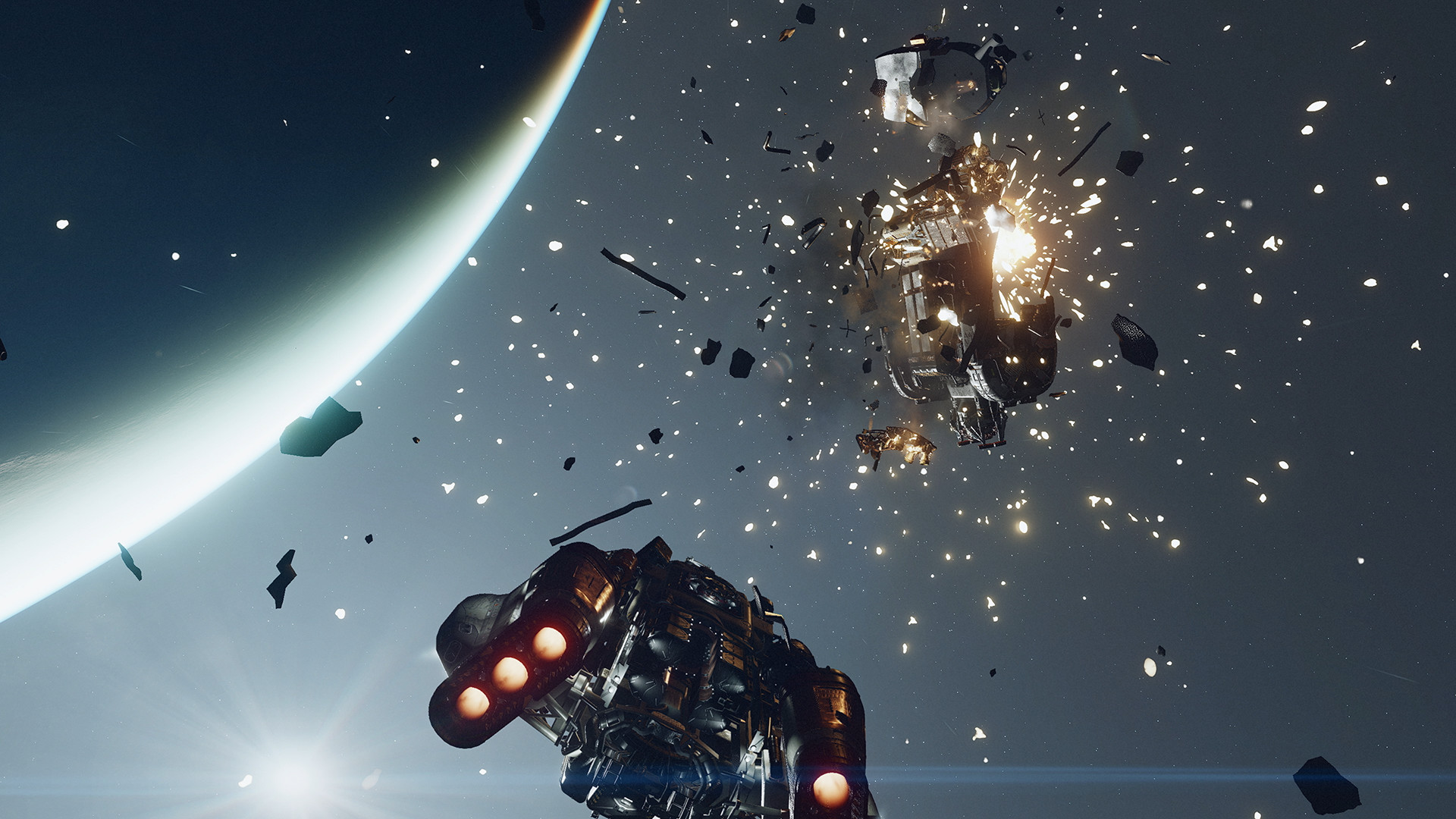
In conclusion, Starfield is a beautiful game that makes great use of the Creation 2 engine to bring its vision to life. It doesn’t break new ground in terms of rendering techniques, but it makes good use of traditional techniques to create a crisp visual presentation. Everything from the environmental fidelity to the smooth animations and the NASA Punk designs come together to make a compelling experience that feels worthy of the years of hype and anticipation.
It performs pretty well on both PC and Xbox Series X, and it’s also one of the more stable releases from the developer with very few technical issues to speak of. Starfield has set a new benchmark for Bethesda RPGs, and we are really excited to see what the future holds for the Creation Engine and the many projects that utilize the latest iteration of this engine.














